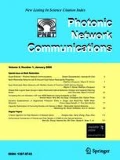Abstract
In Optical Burst-Switched (OBS) networks employing Just Enough Time (JET) signalling, Burst-Control Packets request resources at intermediate nodes following a one-way reservation protocol, that is, requested resources are not confirmed back to the source. Hence, data bursts are transmitted without any guarantees, and it sometimes occurs that these are dropped at a certain hop in the source–destination path, hence wasting resources at previous hops. This effect is specially harmful if some connections are abusing of the global shared resources, violating their respective Service Level Agreements, thus causing: (1) global performance degradation; and, (2) unfair service received by other connections. This article proposes “Random Packet Assembly Admission Control”, an admission control mechanism for OBS networks that moderates the two problems above. The mechanism monitors the network load status, detects which links are heavily loaded and decides which flows among the total traversing them require throughput decrease, on attempts to alleviate congestion and benefit other flows which are not abusing from the network. Such throughput decrease consists of preventive packet dropping during the assembly process at the ingress nodes of the OBS network, thus making no use of the network core. The numerical results show a substantial increase in the throughput experienced by well-behaved flows, and fundamental fairness achievement in the use of optical resources.
Similar content being viewed by others
References
Turner J.: Terabit burst switching. J. High-Speed Netw. 8, 3–16 (1999)
Verma S., Chaskar H., Ravikanth R.: Optical burst switching: a viable solution for Terabit IP backbone. IEEE Netw. 14, 48–53 (2000)
Chen Y., Qiao C., Yu X.: Optical burst switching: a new area in optical networking research. IEEE Netw. 18(3), 16–23 (2004)
Yoo, M., Qiao, C.: Just-enough time (JET): a high-speed protocol for bursty traffic in optical networks. In: Proceedings of the IEEE/LEOS Conference on Technologies for a Global Information Infrastructure 1997, pp. 26–27. August (1997)
Widjaja I.: Performance analysis of burst admission-control protocols. IEE Proc. Commun. 142(1), 7–14 (1995)
Yoo M., Qiao C., Dixit S.: QoS performance of optical burst switching in IP over WDM networks. IEEE J. Sel. Areas Commun. 18, 2062–2071 (2000)
Hernández J.A., Aracil J., de Pedro L., Reviriego P.: Analysis of blocking probability of data bursts with continuous-time variable offsets in single-wavelength OBS switches. IEEE/OSA J. Lightwave Technol. 26(12), 1559–1568 (2008)
Barakat N., Sargent E.H.: Analytical modeling of offset-induced priority in multiclass OBS networks. IEEE Trans. Commun. 53(8), 1343–1352 (2005)
Tan S.K., Mohan G., Chua K.C.: Feedback-based offset time selection for end-to-end proportional QoS provisioning in WDM optical burst switching networks. Compu. Commun. 30(4), 904–921 (2007)
Chen Y., Qiao C., Hamdi M., Tsang D.H.K.: Proportional differentiation: a scalable QoS approach. IEEE Commun. Mag. 41(6), 52–58 (2003)
Lazzez, A., El Fatmi, S.G., Boudriga, N., Obaidat, M.S.: A dynamic QoS-based scheme for admission control in OBS networks. In: Proceedings of the ICC 2007, pp. 449–454 (2007)
Ge A., Callegati F., Tamil L.S.: On optical burst switching and self-similar traffic. IEEE Commun. Lett. 4(3), 98–100 (2000)
Kelly F.P.: Blocking probabilities in large circuit-switched networks. Adv. Appl. Prob. 18, 473–505 (1986)
Rosberg, Z., Vu, H.L., Zukerman, M., White, J.: Blocking probabilities of optical burst switching networks based on reduced load fixed point approximations. In: Proceedings of the INFOCOM 2003, vol. 3, pp. 2008–2018. San Francisco, CA, USA, March 2003
Karagiannis, T., Molle, M., Faloutsos, M., Broido, A.: A nonstationary Poisson view of Internet traffic. In: Proceedings of the INFOCOM 2004, vol. 3, pp. 1558–1569. Honk Kong, PRC, March 2004
Barry, R.A., Humblet, P.A.: Models of blocking probability in all-optical networks with and without wavelength changes. In: Proceedings of the INFOCOM 1995, pp. 4a.1.1–4a.1.11. Boston, MA, USA (1995)
Ross K.W.: Multiservice loss models for broadband telecommunication networks. Springer-Verlag, London (1995)
Whitt W.: Blocking when service is required from several facilities simultaneously. ATT Tech. J. 64(8), 1807–1856 (1985)
de Vega Rodrigo M., Remiche M.-A.: Planning OBS networks with QoS constraints. Photon. Netw. Commun. 14(2), 229–239 (2007)
Author information
Authors and Affiliations
Corresponding author
Rights and permissions
About this article
Cite this article
Reviriego, P., Hernández, J.A. & Aracil, J. Assembly admission control based on random packet selection at border nodes in Optical Burst-Switched networks. Photon Netw Commun 18, 39–48 (2009). https://doi.org/10.1007/s11107-008-0168-4
Received:
Accepted:
Published:
Issue Date:
DOI: https://doi.org/10.1007/s11107-008-0168-4




